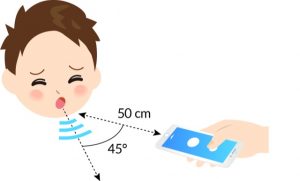
Cough audio streams were recorded on iPhone 6 phones held 25-50 cm away from the patient’s mouth, with the microphone angled at 45 degrees to avoid air hitting the microphone
An Australian smartphone app has been shown to distinguish between the cough sounds in children with various respiratory disorders.
The app was able to diagnose asthma, croup, pneumonia, lower respiratory tract disease and bronchiolitis with 81 – 97% accuracy in a study of 585 children recruited from two hospitals in WA.
The research, published in Respiratory Research, involved automated cough analysis technology – similar to voice recognition technology – trained to recognise characteristic features of coughs from different respiratory diseases.
The app was used to categorise the coughs of children, aged 29 days to 12 years, with the additional input of parent-reported symptoms. The findings were compared to a diagnosis reached by a panel of paediatricians with access to usual clinical data including imaging.
The study found excellent diagnostic agreement results for all children with asthma/ reactive airway disease (RAD), pneumonia, lower respiratory disease and croup.
For example, the positive percent agreement (PPA) was 97% and the negative percent agreement (NPA) was 91% for asthma/RAD. Bronchiolitis achieved a PPA of 84% and a NPA of 81%.
“The algorithm’s performance for RAD was excellent (PPA 97%, NPA 91%) and it is significant that the analyser was able to diagnose RAD at a high-performance level without the need for bronchodilator-response testing,” the study said.